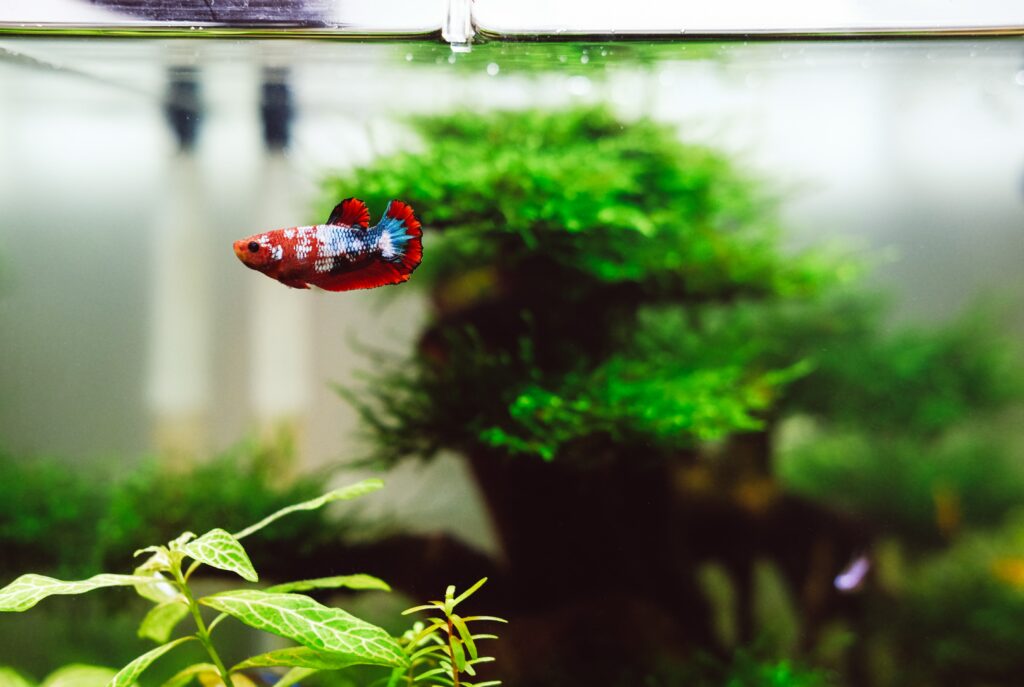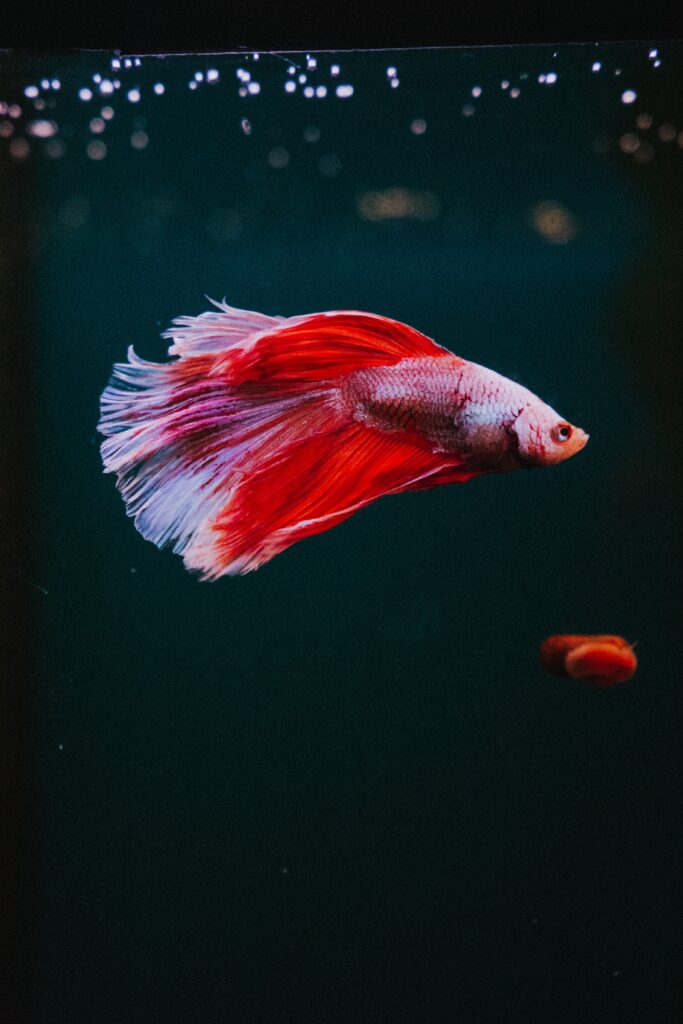Hey there, Betta buddy! 🐟
So, you’ve been circling around that age-old question, haven’t you? How Often Should You Feed a Betta Fish Bloodworms? Trust me; I remember scratching my head over this one too. You see, these little wriggly bloodworms seem like the ultimate treat. Like offering chocolates to kids, moderation becomes the key, just like with kids.
But what does moderation even mean when talking about our little finned friends? Too little, and we feel guilty for depriving them. Too much, and we’re overindulging, risking their health. It’s a delicate balance, really, like dancing on a tightrope.
Even though our Betta buddies can’t jot down their favorite meals in a notebook for us, a little insight and watchfulness can help us decode their dietary wishes!
So, buckle up! We’re diving deep into the Betta dietary world. By the end, you’ll be navigating the waters of Betta, feeding like a seasoned captain. Ready for the adventure? Dive right in!
Role of Bloodworms in a Betta’s Diet
Alright, onto the good stuff! 🎉
Now, bloodworms aren’t just any regular treat. They’re like the gourmet snacks of the underwater world. And for good reason!
- Protein Powerhouses: Betta fish are primarily carnivorous. In the wild, they’re feasting on insects and tiny larvae. Bloodworms, the larvae of midge flies, fit perfectly into this natural diet. They’re packed with protein, making them a fantastic dietary supplement for keeping those fins fluttering energetically.
- Tantalizing Taste: Let’s face it, Betta fish love bloodworms. Offer them, and you’ll quickly see those little eyes light up with excitement. They’re drawn to the movement, the taste, the whole package!
- Not a Complete Meal: Here’s the kicker, though. While bloodworms are nutritional wonders, they don’t provide all the nutrients your Betta needs. Think of them as a delectable dessert or a unique side dish. They’re fantastic in moderation but should be something other than a well-rounded Betta meal.
- Great for Conditioning: If you’re thinking of breeding your Bettas or ensuring they’re in tip-top shape, bloodworms can be an excellent addition. They help condition your Betta, making them look vibrant and feel vigorous.
- A Word of Caution: Like we might get an upset tummy from overindulging in our favorite treats, too many bloodworms can lead to Betta bloating and other digestive issues. So, while they’re a fantastic treat, it’s essential to serve them wisely.
There you have it! Bloodworms play a fascinating role in a Betta’s diet, offering nutritional benefits and excitement during meal times. Yet, as with all good things, they come with a “serve responsibly” tag. So, let’s keep diving and discover how to strike that perfect balance, shall we?

How Often Should You Feed A Betta Fish Bloodworms?
Diving further into our aquatic culinary journey, let’s address the burning question head-on! 🤔
- The Golden Rule – Moderation: I can’t stress this enough. While it’s tempting to see our Betta buddies’ eyes light up every time we offer them bloodworms, it’s like giving candy to a kid. You wouldn’t do it at every meal, right? As a general guideline, offering bloodworms 1-2 times a week works wonders.
- Treat vs. Staple: Bloodworms should remain in the treat category. They’re the sprinkle of excitement in your Betta’s dietary routine. Your Betta’s main meals should be well-rounded, high-quality Betta pellets or flakes that offer a balanced blend of nutrients.
- Factors to Consider: Every Betta is unique. Some are more active swimmers, darting around their tanks with gusto. Others might be more laid-back, preferring a leisurely swim. Your Betta’s age, size, and overall health can also influence how often you should offer these tasty treats. It’s always good to observe and adjust.
- Fresh, Freeze-dried, or Frozen?: The format of the bloodworms can play a role too. Fresh or frozen bloodworms are more nutritious but need careful handling to avoid contamination. Freeze-dried versions are convenient and reduce the risk of transferring any parasites or diseases. But remember to rehydrate freeze-dried bloodworms before feeding to make them easier for your Betta to digest.
- Consistency is Key: While it’s okay to occasionally spoil your Betta with an extra serving, maintain a consistent feeding routine. This consistency helps regulate their metabolism and keep their digestive systems in check.
In wrapping up this segment, think of bloodworms as the cherry on top of your Betta’s dietary sundae. They add a dash of excitement and a boost of nutrition, but just like cherries, they shouldn’t make up the whole dessert!
Keep an eye on your fishy friend’s reaction after feeding, adjust as needed, and soon you’ll find the sweet spot of how often to treat them with bloodworms.
Ready to explore more? Let’s dive even deeper!
How Many Bloodworms Should You Feed Your Betta?
Alright, now that we’ve got the ‘when’ sorted, let’s delve into the ‘how much.’ 🧐
- Size Does Matter: Bloodworms might look tiny, but they’re a decent snack for a Betta. It’s crucial to think in Betta-sized portions. A healthy adult Betta should typically be content with 3-5 bloodworms per treatment session.
- Young vs. Adult Betta: If you’re a proud Betta parent to a younger or smaller fish, you’ll want to scale that number down. Younger Betta fish might only need 1-2 bloodworms to be satisfied.
- Observe Their Appetite: Like us, Betta fish can have varying appetites. Some might be voracious eaters, while others take a more refined approach. Monitor their behavior after feeding. If they eagerly search for more, you can consider adding an extra worm next time. But if they leave some uneaten, it’s a sign to cut back.
- Watch Out for Bloating: Overfeeding can cause bloating in Betta fish, which isn’t just uncomfortable for them but can lead to health issues. It’s essential to strike that right balance.
- Complement with Other Foods: Bloodworms should be a part of a varied diet. Pair them with Betta-specific pellets, flakes, and other treats like daphnia or brine shrimp. This ensures your Betta gets all the nutrients it needs to stay vibrant and healthy.
Feeding your Betta bloodworms is like treating a friend to their favorite snack. You wouldn’t want to stuff them full, but you’d love to see the joy it brings. Watch your Betta’s reaction, adjust based on their needs, and remember – moderation is your trusty sidekick in this adventure.

Considerations When Feeding Bloodworms to Betta Fish
Overfeeding
Ah, overfeeding. It’s a pitfall many of us enthusiastic Betta parents can quickly tumble into. I mean, who can resist those pleading Betta eyes? 🐟👀 But here’s why we must resist the urge and be mindful.
- Bloating and Constipation: One of the most immediate concerns with overfeeding bloodworms—or any food, really—is bloating. A bloated Betta can struggle to swim, often floating awkwardly or turning on its side. Constipation can follow, making your fishy pal genuinely uncomfortable.
- Water Quality Deterioration: Uneaten food, whether bloodworms or pellets, sinks and decays. This decay can turn your tank’s water into a toxic environment, increasing ammonia levels and stressing your Betta out.
- Fatty Liver Disease: Just like in humans, excessive fat intake in Bettas can lead to a condition similar to fatty liver disease. It’s a slow and silent ailment but can drastically reduce your Betta’s lifespan.
- Reduced Lifespan: Consistent overfeeding can shorten a Betta’s life. While they might seem happy to gobble up those extra bloodworms, it can take a toll on their overall health and vitality in the long run.
- Immune System Weakness: Overeating and poor water quality can combine to weaken a Betta’s immune system. A stressed and unhealthy Betta becomes more susceptible to diseases and infections.
- Behavioral Changes: Overfed Bettas can become lethargic. They might not display their usual curiosity or zest for life. This can be heartbreaking, especially if you’re used to seeing your Betta zip around with enthusiasm.
- Tips to Prevent Overfeeding: Offering small, controlled amounts is the trick. If you notice uneaten food, remove it promptly. Also, having a feeding schedule and sticking to it is super helpful.
Remember, we aim to keep our Betta buddies happy, healthy, and thriving for as long as possible. So, while those extra treats might earn you some temporary fishy love, it’s our responsibility to ensure their long-term well-being. Keep those waters clear and the food portions right, and enjoy the delightful company of your vibrant Betta for years to come!
Balancing the Diet with Other Foods
The mantra here? Diversity is the spice of life, even for our Betta buddies. Let’s see how we can mix things up:
- High-Quality Betta Pellets: The backbone of a Betta’s diet. These are specifically formulated for their nutritional needs. They offer a balanced mix of proteins, vitamins, and minerals.
- Flakes: While pellets often reign supreme, Betta-friendly flakes can be a good change of pace and ensure they’re getting a varied diet.
- Live Foods: Daphnia, brine shrimp, and even tiny feeder guppies can be introduced occasionally. These add nutritional value and stimulate the Betta’s natural hunting instincts.
- Vegetable Matter: Believe it or not, Bettas can benefit from green in their diet. Boiled and finely chopped peas (with the skin removed) can aid digestion and prevent constipation.
- Vitamins and Supplements: Several water additives are available that provide essential vitamins and minerals, further ensuring your Betta’s health and vibrancy.
- Rotate and Monitor: Just like us, Bettas can be picky or develop favorites. It’s good to rotate foods to make sure they’re getting a diverse diet. And always watch their reaction to different foods; if they reject a specific type, don’t force it.
Conclusion
Being a Betta parent is a joy. These vibrant little swimmers add a splash of color to our lives and teach us about responsibility, balance, and the simple pleasures of care. In feeding them, like all aspects of care, the key is balance and moderation. By offering them a varied diet, not only do you ensure their health, but you also get to witness the sheer range of behaviors and preferences that make each Betta unique. From the excitement of chasing live food to the contentment post a bloodworm treat—every moment is a revelation. Here’s to many more delightful feeding times and a happy, thriving Betta!
